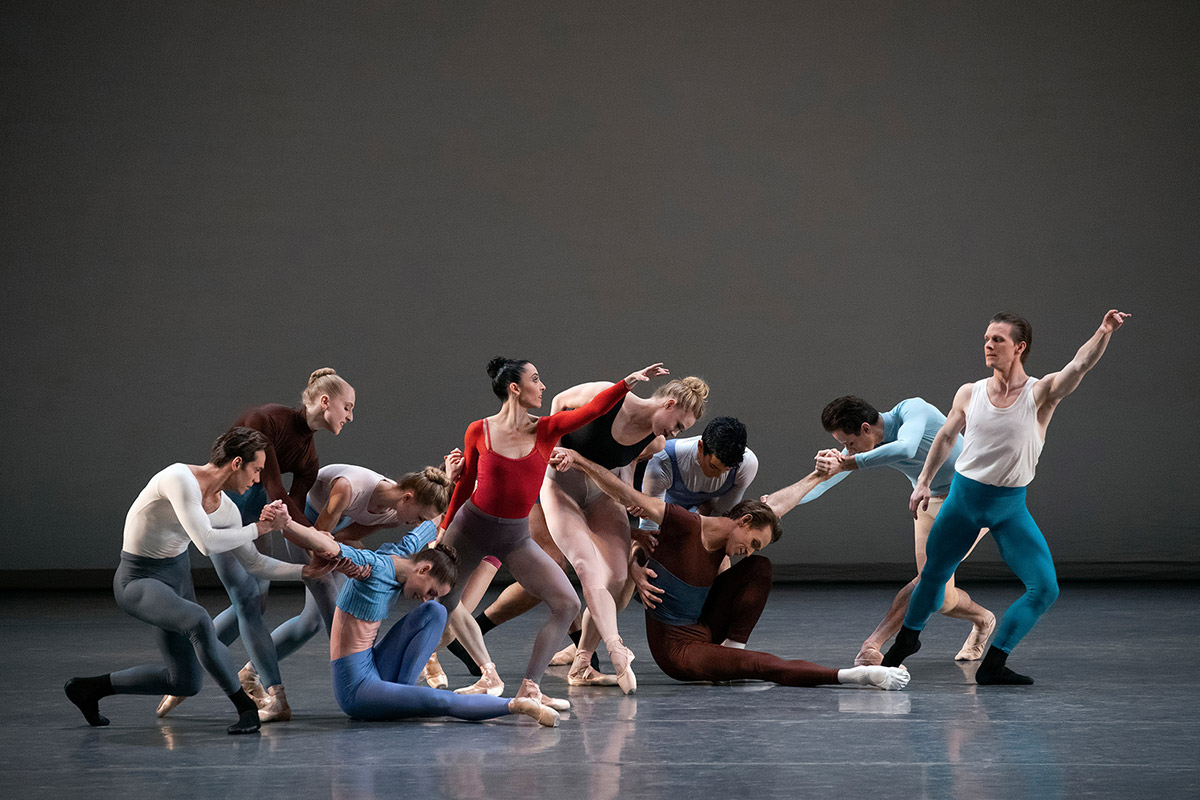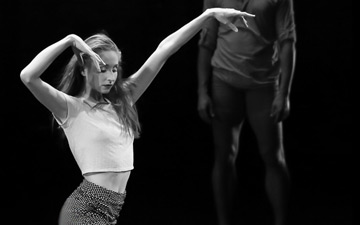
© Erin Baiano. (Click image for larger version)
New York City Ballet
Classic NYCB II: In G Major, Rotunda, DGV: Danse à Grande Vitesse
★★★✰✰
New York, David H. Koch Theater
28 February 2020
www.nycballet.com
davidhkochtheater.com
Clean and Bright
In the last week of its winter season, New York City Ballet unveiled a new work by its resident choreographer, Justin Peck, to a score by the popular neo-Minimalist composer Nico Muhly. It was a homecoming of sorts for Peck, who has spent the last year working on Stephen Spielberg’s remake of West Side Story. (The film will be released in December.) And that is precisely what the ballet feels like. Rotunda revolves around a series of gatherings. The ballet’s short sections begin with a circle, in which each dancer is essential. When one is missing, the circle can’t close. When the particles unite, the organism comes alive.

© Erin Baiano. (Click image for larger version)
It’s a nice idea, and in fact everything about Rotunda is friendly, collegial, and bright, from the faces of the dancers to the rehearsal-like costumes by Reid Bartelme and Harriet Jung and the crisp, clean steps Peck has devised. The music, too. Muhly’s score, in which individual instruments brighten up each section, unspools pleasantly beneath the steps, its complex rhythms bubbling along without creating any significant sense of momentum or tension.
Within this collegial structure, Peck pulls out individual dancers, in ones, twos, and threes. He has worked with most of them before. Calmly, he shows their qualities: Gonzalo García is the dreamer; Sara Mearns the spitfire; Brittany Pollack, perhaps the most Peck-ian of dancers, offers pin-prick precision and lack of mannerism. All are well-versed in the choreographer’s quick and clean vocabulary of movement.

© Erin Baiano. (Click image for larger version)
Which is to say there are no real surprises here. Low-key and a touch aimless, Rotunda is a dance about dancers, not that different from his last full work of the company, Principia. The choreography is looser here – busy but lacking in direction, like a series of sketches or doodles. The overall effect is anodyne, as if Peck were reacquainting himself with the company, settling in.
The big revelation of the night came earlier, in a performance of Jerome Robbins’ 1975 ballet In G Major, set to Ravel’s gorgeous, jazzy piano concerto in G. Jovani Furlan, a former Miami City Ballet dancer who recently joined City Ballet’s ranks, débuted alongside the ever-versatile Unity Phelan. (Isn’t it high time Phelan was promoted to principal?) It was a spectacular début for Furlan. What a find! He combines many wonderful qualities: fast, clean, technique; extraordinary musicality and phrasing; confident and engaged partnering; and a face that communicates joy and presence in each moment. At times he looks twice as alive as anyone else onstage.

© Erin Baiano. (Click image for larger version)
All qualities especially suited to this work, a frolicsome romp by the seaside (the beachy costumes are by the French designer Erté) interrupted by an extended, dream-like pas de deux for a couple in white. Furlan and Phelan are the “it” couple in this beachside scenario. Phelan’s entry in the first movement is accompanied by a jazzy, sexy clarinet melody; she leads with her hips, blissfully unaware of her effect on all those around her. Furlan, in turn, sexily unfolds each leg, stretching out as he advances through space, a Hermes in slow motion. The corps, which looked rather ragged, could take a tip or two from the stretch and finesse of his transitions.
In the slow second movement, set in ¾ time, the two dancers walk toward and away from each other, tentatively, with a sense of mystery, accompanied first by the piano, and then by the oboe. Walking, gliding, floating, they test the waters of their budding romance. The pas de deux seems to contain within it an entire summer. Furlan filled his gestures with meaning: when he held his arms out to Phelan, it was an invitation, echoed by the eagerness in his eyes. Phelan, still feeling her way into the role, communicated vulnerability and a touch of shyness.

© Erin Baiano. (Click image for larger version)
Let’s hope the ballet stays in the repertory for a while. Not so Christopher Wheeldon’s DGV: Danse à Grande Vitesse, a pièce d’occasion that has lost whatever zing of excitement it ever had. Michael Nyman’s driving, dynamically un-varied score grows increasingly grating with multiple viewings. As does the repetitive choreography in which the dancers become pistons and gears. Again and again the women are lifted high, arms and legs like spokes in a wheel.
I began the season by wondering: how is the company looking under its new leadership team, after all the upheaval it has experienced in the last few seasons? I end it the same way. The male ranks are looking a bit thin: retirements, the still-recent loss of two principal dancers, the absence of another, and several injuries have taken their toll. (Adrian Danchig-Waring went out in the final week.) Furlan has arrived just in time. Some of the ballets have looked as if it could have done with a few more hours of rehearsal. Rotunda proves that new choreography doesn’t always provide the shot of adrenaline the company needs. But there have been highlights too: the new Voices, by Ratmansky, which pulled new colors from its cast; riveting performances of Polyphonia, by Wheeldon. Lauren Lovette particularly shone in both. As well as a newly confident, expansive Teresa Reichlen in Monumentum Pro Gesualdo and Movements for Piano and Orchestra. A solid base on which to build.

















You must be logged in to post a comment.